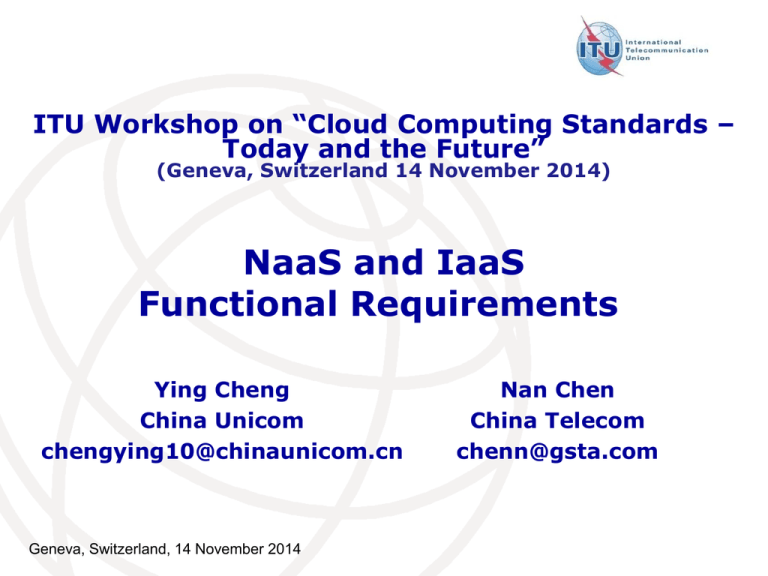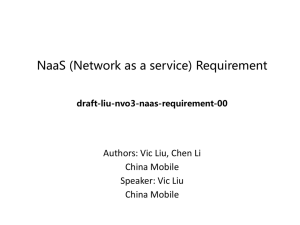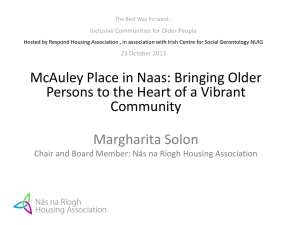NaaS and IaaS Functional Requirements ITU Workshop on “Cloud Computing Standards –
advertisement

ITU Workshop on “Cloud Computing Standards – Today and the Future” (Geneva, Switzerland 14 November 2014) NaaS and IaaS Functional Requirements Ying Cheng China Unicom chengying10@chinaunicom.cn Geneva, Switzerland, 14 November 2014 Nan Chen China Telecom chenn@gsta.com Contents Part I: Functional Requirements of Network as a Service Based on Recommendation ITU-T Y.3512 (Cloud computing - Functional requirements of Network as a Service) Part II: Functional Requirements of Infrastructure as a Service Based on Recommendation ITU-T Y.3513 (Cloud computing - Functional requirements of Infrastructure as a Service) Geneva, Switzerland, 14 November 2014 2 Contents Part I: Functional Requirements of Network as a Service Based on Recommendation ITU-T Y.3512 (Cloud computing - Functional requirements of Network as a Service) Geneva, Switzerland, 14 November 2014 3 Summary of Y.3512 Scope High level concept of NaaS; Functional requirements of NaaS application, NaaS platform and NaaS connectivity; Typical NaaS use cases of NaaS application, NaaS platform and NaaS connectivity. Statistics 61 contributions from 8 sector members: China Unicom, Orange Polska SA, Orange, ETRI, ZTE, Microsoft, Huawei, Alcatel-Lucent Shanghai Bell 8 meetings: 7 physical meetings and 1 e-meeting 13 use cases: 3 in general and 10 in detail 26 functional reqts: 4 for NaaS application, 5 for NaaS platform, and 17 for NaaS connectivity Editors Ying Cheng (China Unicom) and Emil Kowalczyk (Orange Polska SA) Geneva, Switzerland, 14 November 2014 4 NaaS concept Network as a Service (NaaS) [Y.3500]: cloud service category in which the capability provided to the cloud service customer is transport connectivity and related network capabilities NaaS services are divided into network application service, network platform service, and network connectivity service. In particular, NaaS connectivity service is an “infrastructure capabilities type” service (limited to networking resources). NOTE – NaaS can provide any of the three cloud capabilities types. Geneva, Switzerland, 14 November 2014 5 NaaS Connectivity: infrastructure capabilities type of service where NaaS CSC can provision and use networking connectivity resources provided by NaaS CSP. This includes for example flexible and extended virtual private network (VPN), bandwidth on demand (BoD), etc. In this category, CSP offers network connections between two or more endpoints, which may include additional network functionalities. NaaS concept (2) NaaS Application: application capabilities type of service where NaaS CSC can use network applications provided by CSP. Examples of NaaS applications include virtual router, virtual content delivery network (vCDN), virtualised evolved NaaSand Platform: platform capabilities packet core (vEPC) of service where NaaS CSC can use virtual firewall type (vFW). the network platform provided by NaaS CSP. The NaaS platform offers one or more software execution environments and one or more programming languages to deploy, manage and run customer-created or customer-acquired network applications. High level concept of NaaS using the layering framework defined in [ITU-T Y.3502] Geneva, Switzerland, 14 November 2014 6 Development methodology of NaaS related WIs Considering the standardization methodology and conventional study sequence, the abstractions of functional entities and their mutual interactions are based on the functional requirements and the corresponding use cases analysis, which form a standardization body together. Therefore, it is required to progress NaaS functional requirements and architecture according to the following steps and priorities. Use Cases Functional Requirements Y.3512 Functional Architecture Y.CCNaaS-arch Additionally, it is needed to align with the high level requirements of NaaS described in the latest edition of Y.3501 (Cloud computing framework and high-level requirements), whose most recent edition is ITU-T Y.3501 (2013). Geneva, Switzerland, 14 November 2014 Source: Appendix I of Y.3512 7 Milestones of NaaS related WIs Timelines Milestones 2012.4 First proposal from China Unicom on NaaS related WI – agreed to be kept in living list of Q27/13 2012.6 Agreed to launch Y.CCNaaS in study period 2013-2016 2013.2 Initial draft Rec of Y.CCNaaS; Use cases and derived reqts on dynamic transport network and flexible and extended VPN; Ying Cheng (China Unicom) and Emil Kowalczyk (Telekomunikacja Polska S.A) are nominated as editors; 2013.6 Re-organization of use cases and functional requirements into three types; Use cases and derived reqts on Cloud CDN, Application/platform capabilities types NaaS provision, BoD, Optimized traffic engineering, Performance on demand 2013.11 Excluding architecture clause from the scope of Y.CCNaaS; New time plan for Y.CCNaaS consent on Q3 2014; New use cases and derived functional reqts on virtual router and service chain 2014.2 Refinement on scope; Modifications on general description including introduction and high level concept of NaaS; 2014.5 Addition and modification of detailed functional reqts in clauses 7-9; Editorial supplements and modifications for the whole document 2014.7 Consent of Y.3512 (former Y.CCNaaS) ; Launch of NaaS series WI Y.CCNaaS-arch and Ying Cheng (China Unicom) , Emil Kowalczyk (Orange Polska SA) , and Qian Gu (China Telecom) are nominated as editors 2014.8 Publishing of Y.3512 after AAP Geneva, Switzerland, 14 November 2014 8 Detailed use cases and functional reqts of NaaS application Detailed use case Derived functional reqts Cloud CDN • Monitoring utilization and delivery performance • Providing efficient management solution • Providing mechanisms allowing for the chaining of NaaS applications Geneva, Switzerland, 14 November 2014 9 Detailed use cases and functional reqts of NaaS platform Detailed use case Derived functional reqts Service chain • Programmable NaaS platform; • Dynamic and flexible network service composition and steering; • Isolation of service chains for tenants Platform provision • Flexible scaling of NaaS platform • Integration of software applications Geneva, Switzerland, 14 November 2014 10 Detailed use cases and functional reqts of NaaS connectivity (1) Detailed use case Derived functional reqts Dynamic transport • Unified SLA for multiple optimized networks network • Leveraging transport networks dynamically • Unified network control mechanism Flexible and • Elastic network reconfiguration extended VPN Bandwidth on • Seamless and end-to-end solution demand service bandwidth allocation • Symmetric or asymmetric capacity of Optimized traffic • Optimized and fine-grained traffic engineering engineering • Coexistence with legacy network services and functions 11 Detailed use cases and functional reqts of NaaS connectivity (2) Detailed use case Performance on demand Derived functional reqts • CSC limited control to services • Centralized control view and abstraction view of resources Virtual Router • • • • • • Private IP addresses and VPNs Logically isolated network partition Overlay network mechanism Overlapped private IP addresses Interworking among different VPN solutions VPN connection in mobile environment Connection to NaaS CSP’s network through public Internet 12 Geneva, Switzerland, 14 November 2014 Contents Part II: Functional Requirements of Infrastructure as a Service Based on Recommendation ITU-T Y.3513 (Cloud computing - Functional requirements of Infrastructure as a Service) Geneva, Switzerland, 14 November 2014 13 Y.CCIaaS in Summary Scope of Y.CCIaaS General description of IaaS Functional requirements of IaaS Typical IaaS use cases 41 related contributions from 7 sector members in 9 meetings Editors CHEN Nan (China Telecom) Peter Tomsu (Cisco) Geneva, Switzerland, 14 November 2014 14 Milestones of Y.3513 Timelines Milestones 2012.4 First proposal from China Telecom on IaaS related WI – agreed to be kept in living list of Q27/13 2012.6 Agreed to launch Y.CCIaaS in study period 2013-2016 2013.2 Initial draft Rec of Y.CCIaaS CHEN Nan (China Telecom) and Orit Levin (Microsoft) are nominated as the editors Mr. Peter Tomsu from Cisco is nominated as the co-editor 2013.6 2014.2 Excluding architecture clause from the scope of Y.CCIaaS New time plan for Y.CCIaaS consent on Q3 2014 2014.7 Consented Geneva, Switzerland, 14 November 2014 15 The definition of IaaS Infrastructure as a Service [ITU-T Y.3500] cloud service category in which the cloud capabilities type provided to the cloud service customer is an infrastructure capabilities type NOTE – The cloud service customer does not manage or control the underlying physical and virtual resources, but does have control over operating systems, storage, and deployed applications that use the physical and virtual resources. The cloud service customer may also have limited ability to control certain networking components (e.g. host firewalls). Geneva, Switzerland, 14 November 2014 16 High level concept of IaaS Geneva, Switzerland, 14 November 2014 17 IaaS service functions computing service functions allow CSC to provision and use processing resources. CSC can perform operations relevant to processing resources including machine (physical or virtual machine) lifecycle operations and functions such as VM migration, backup, snapshot, clone and reservation. storage service functions allow CSC to use storage resources. CSC can perform operations relevant to storage resources including lifecycle operations and functions such as snapshot, backup, I/O performance, load balance and reservation. network service functions allow CSC to use networking resources. CSC can integrate infrastructure resources using network relevant functions such as IP address, network isolation (e.g. VLAN), virtual networking (e.g. virtual switch), load balance and firewall. Geneva, Switzerland, 14 November 2014 18 Computing service functions migration scaling snapshot clone Physical Computing machine Service Virtual backup machine time synchronization reservation image template Geneva, Switzerland, 14 November 2014 19 Storage service functions Storage migration Storage resource reservation Storage Storage snapshot service I/O Storage performance backup Geneva, Switzerland, 14 November 2014 20 Network service functions Network policy migration Network QoS IP address Network Isolation Virtual networking Load balance Network Service Firewall Gateway Network configuration Geneva, Switzerland, 14 November 2014 21 The relationship between IaaS and NaaS Regarding the network connectivity, one important difference between IaaS and NaaS is that IaaS is a cloud service category that is offered in only one flavour of cloud capability type, and that is infrastructure capabilities type [ITU-T Y.3500]. However, NaaS is a cloud service category that can be offered in all three cloud capabilities types. Geneva, Switzerland, 14 November 2014 22 Thanks for your attention! Geneva, Switzerland, 14 November 2014 23

